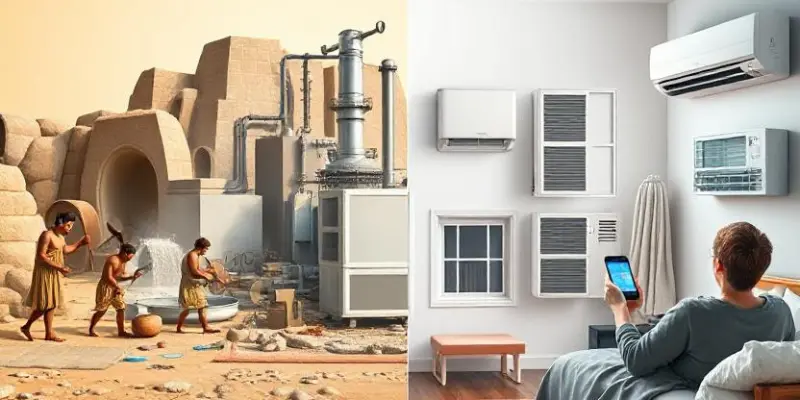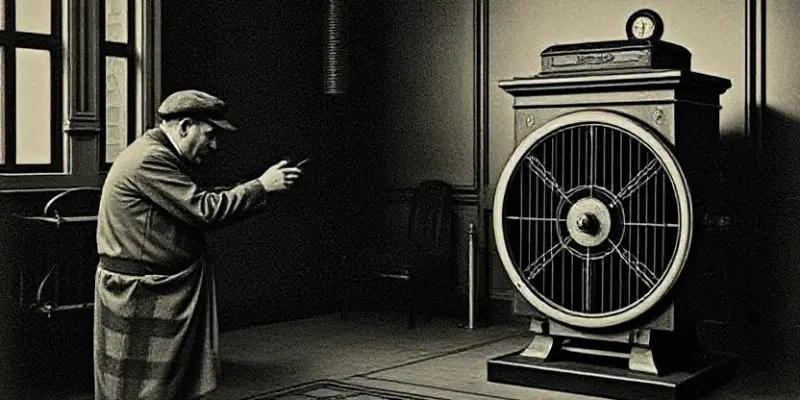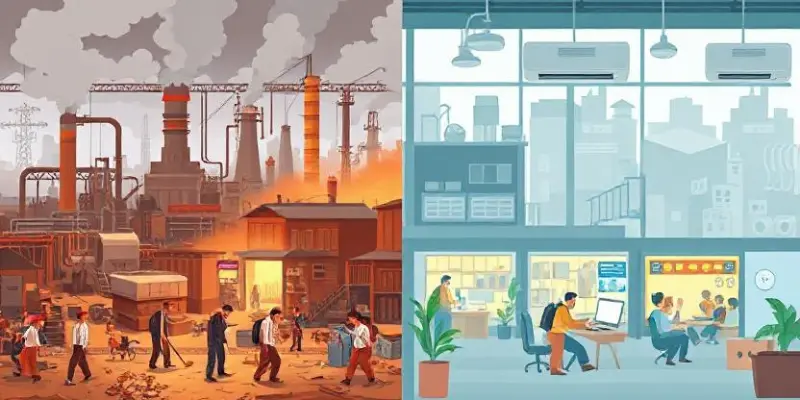History of Air Conditioners: How It Changed Homes and Workplaces
Published: 14 Oct 2025
Did you know that humans have been trying to stay cool long before modern air conditioners were invented? Ancient Egyptians hung wet mats on windows, and Romans built fountains and clever ventilation systems to make their homes more comfortable. These early methods may sound simple, but they show how people have always looked for ways to beat the heat.
The History of Air Conditioner is more than just a story of machines-it shows how technology changed the way we live, work, and relax. From factories to movie theaters to our own bedrooms, air conditioning has shaped modern life in ways many of us take for granted. Understanding its history helps us appreciate the comfort we enjoy every day.
Background and Timeline of Air Conditioners
The history of AC goes back more than a century, but humans tried to stay cool long before modern machines existed. Ancient Egyptians, Greeks, and Romans used simple methods like wet mats, fountains, and thick walls to keep their homes comfortable.
The modern air conditioner was invented in 1902 by Willis Carrier, an American engineer. He created the first system to control humidity and temperature for a printing factory. This invention not only made factories more efficient but also changed how people lived and worked.

In the 1920s and 1930s, air conditioners started appearing in movie theaters, offices, and department stores. By the 1950s, homes began getting air conditioning, especially in the United States. The invention became culturally significant because it made hot cities like Las Vegas and Houston more livable, influencing migration and lifestyle.
Other key figures include engineers and companies who improved efficiency, introduced home units, and developed modern technologies like split ACs and smart air conditioners. These innovations shaped the way we enjoy comfort today.
Main Events in the History of Air Conditioning
Piyara-The journey of air conditioners shows how humans have always looked for ways to stay cool. From simple ancient methods to modern smart ACs, each step changed the way we live and work.
- 1902 → Willis Carrier invents the first modern air conditioner
- 1914 → First large-scale AC system installed in a printing plant
- 1920s → AC was introduced in movie theaters and offices
- 1930s → Air conditioning expands to department stores and public buildings
- 1950s → Air conditioners became common in homes, especially in the United States
- 1960s–1970s → Development of compact window units and split AC systems
- 1980s → Introduction of more energy-efficient AC systems
- 1990s → Use of eco-friendly refrigerants and improved technology
- 2000s → Smart and inverter air conditioners became popular
Let’s discuss everything in detail one by one. Are you ready? Let’s see.
1902 → Willis Carrier Invents Modern AC
- Date: 1902
- Location: Buffalo, New York, USA
- Details/Outcome: Willis Carrier created the first modern air conditioner to control humidity and temperature for a printing factory. This invention made industrial production more efficient and marked the start of modern air conditioning technology.

1914 → First Large-Scale AC System Installed
- Date: 1914
- Location: Pittsburgh, Pennsylvania, USA
- Details/Outcome: The first large-scale AC system was installed in a printing plant to cool a building and improve production quality. This showed that AC could be used for industrial applications beyond small experiments.
1920s → AC in Movie Theaters and Offices
- Date: 1920s
- Location: United States
- Details/Outcome: Air conditioners were installed in movie theaters and offices to make spaces comfortable for people. This helped AC gain popularity among the general public.
1930s → Expansion to Department Stores and Public Buildings
- Date: 1930s
- Location: United States
- Details/Outcome: AC began appearing in large department stores and public buildings. It improved customer comfort and increased business sales, showing how AC impacted both lifestyle and economy.
1950s → AC Becomes Common in Homes
- Date: 1950s
- Location: United States
- Details/Outcome: Home air conditioners became affordable and widely used. This made living in hot regions like the southern U.S. much more comfortable and changed daily life.
1960s–1970s → Compact Window Units and Split AC Systems
- Date: 1960s–1970s
- Location: Worldwide (developed in the U.S. and exported)
- Details/Outcome: AC technology became smaller and more versatile. Window units and split ACs allowed homes and offices to cool rooms efficiently, making AC accessible to more people.
1980s → Introduction of Energy-Efficient ACs
- Date: 1980s
- Location: Worldwide
- Details/Outcome: Engineers focused on energy-saving designs, reducing electricity use while maintaining cooling performance. This made AC more affordable to run and environmentally friendly.
1990s → Eco-Friendly Refrigerants and Improved Technology
- Date: 1990s
- Location: Worldwide
- Details/Outcome: New refrigerants replaced older ones that were harmful to the ozone layer. AC units became safer for the environment, and technology improvements made systems quieter and more reliable.
2000s → Smart and Inverter Air Conditioners
- Date: 2000s
- Location: Worldwide
- Details/Outcome: Introduction of smart ACs and inverter technology allowed users to control temperature more precisely. These systems save energy, offer comfort, and can be controlled via smartphones or automated sensors.
Impact
The invention of air conditioners did more than just cool rooms; it changed the way people live, work, and interact with their environment.
Short-Term Effects
The invention of modern air conditioners quickly changed workplaces, homes, and public spaces. Factories could operate more efficiently in hot weather, and workers were more comfortable, which increased productivity. Movie theaters, offices, and stores became more inviting, attracting more people. In hot regions, AC made daily life easier, helping people work, shop, and enjoy leisure activities without struggling in the heat.

Long-Term Effects
Over time, air conditioning has had a major cultural and social impact. Cities in hot climates grew faster because people could live comfortably in previously unbearable conditions. AC also influenced architecture-buildings could have bigger glass windows, and indoor spaces became more modern and comfortable. Politically, it allowed governments and organizations to maintain operations in extreme climates. Culturally, air conditioning changed lifestyle habits, from indoor entertainment to migration patterns, and became a symbol of modern comfort and technological progress.
Key Figures
Several people played a major role in creating and improving the air conditioner, shaping the way we stay cool today.
Willis Carrier (1876–1950)
- Contribution: Invented the first modern air conditioner in 1902.
- Relevance: Carrier solved problems of humidity and temperature control in factories, which improved production and comfort. He is called the “Father of Modern Air Conditioning” because his invention started the AC revolution.
David St. Pierre Carrier
- Contribution: Worked alongside Willis Carrier in promoting air conditioning for industrial and commercial use.
- Relevance: Helped expand AC beyond factories to offices, theaters, and public buildings, making it more common in everyday life.
Engineers and Companies of the 20th Century
- Contribution: Developed window units, split systems, and energy-efficient designs.
- Relevance: Made air conditioning smaller, affordable, and available for homes worldwide. These improvements shaped modern comfort and accessibility.
Modern Innovators
- Contribution: Created smart ACs, inverter technology, and eco-friendly refrigerants.
- Relevance: Improved energy efficiency, environmental safety, and convenience, allowing users to control AC systems with precision.
Different Perspectives on Air Conditioner History
The history of AC can be seen in many ways, depending on who looks at it.
Historical Perspective
Historians often see the invention of modern air conditioning as a technological breakthrough. They focus on how Willis Carrier and other inventors solved industrial problems like humidity and heat in factories. From this view, AC is important for its role in innovation, science, and engineering.
Societal Perspective
Societies sometimes focus on how air conditioning changed daily life. People in hot regions could now live, work, and enjoy leisure comfortably. Cities grew, migration patterns changed, and lifestyles adapted. From this perspective, AC is not just a machine-it’s a tool that shaped culture, comfort, and convenience.
Environmental Perspective
Some people view the history of AC critically because older air conditioners used refrigerants that harmed the environment. Modern innovations like eco-friendly refrigerants and energy-efficient designs show society’s growing awareness of environmental responsibility.
Cultural Perspective
In pop culture, air conditioning symbolizes modern comfort and luxury. Historians and cultural experts note that AC influenced movies, shopping habits, and even architecture, making indoor spaces more inviting and comfortable.
Myths and Misconceptions About AC History
Over time, several myths have grown around air conditioners. Let’s clarify them.
Myth 1: Air Conditioners Were Always Common
- Fact: Many people think AC has always been available in homes. Actually, modern air conditioners were invented in 1902, and home units became common only in the 1950s. Before that, only factories, theaters, and wealthy offices had AC.
Myth 2: Willis Carrier Invented Cooling for Homes First
- Fact: Willis Carrier created AC to control humidity and temperature in factories, not for homes. Home air conditioning came later, after engineers made smaller, affordable units.
Myth 3: Ancient People Had Air Conditioners
- Fact: Some believe Egyptians or Romans had air conditioners. In reality, they used simple cooling methods like water, shade, and ventilation; no machines existed back then.
Myth 4: Air Conditioning Is Only About Comfort
- Fact: AC is more than comfort. It helped industries, workplaces, and cities grow. Factories ran better, offices were productive, and hot cities became livable.
Conclusion
The history of air conditioners shows how humans have always worked to stay comfortable in hot weather. From ancient cooling methods to Willis Carrier’s invention in 1902, and from factory ACs to smart home systems today, air conditioning has changed the way we live, work, and enjoy life.
Reflecting on this history reminds us that technology is more than convenience-it shapes society, culture, and even the growth of cities. Next time you enjoy a cool room on a hot day, remember the long journey that made it possible.
For those interested, you can explore more about the science behind air conditioners or how energy-efficient and eco-friendly ACs are changing our future.
Common Questions About the History of AC
You may have some questions in your mind about the history of air conditioners, so don’t get tense now. We have already prepared the most common questions for you. We are sharing them here to help you understand the story behind this amazing invention.
- Who invented the first modern air conditioner?
- When was air conditioning first used in homes?
- Why was the air conditioner originally invented?
- How did air conditioning impact factories and workplaces?
- Which cities or regions benefited the most from air conditioning?
- How did air conditioners change daily life and culture?
- Who were the important figures in the development of air conditioning?
- What were the early methods of cooling before modern AC?
- How has air conditioning technology evolved over time?
- What environmental or social effects did air conditioners have?
Now we discuss the answers to all the questions one by one in detail.
The first modern air conditioner was invented by Willis Carrier in 1902. He made it to control humidity and temperature in a printing factory. This invention helped factories work better and stay cool. Carrier is called the “Father of Modern Air Conditioning.”
Air conditioning first became common in homes in the 1950s. Before that, only factories, offices, and theaters had AC. Small and affordable units were made for homes in this period. This made living in hot weather easier for many families.
The air conditioner was invented to control heat and humidity in factories. It helped improve production and keep workers comfortable. People did not invent it for home use at first. Later, engineers made smaller units for offices and homes.
Air conditioning made factories and offices cool and comfortable. Workers could do their jobs better without feeling very hot. Production and work quality improved in factories. It also helped offices and stores attract more people.
Hot cities, especially in the southern United States, benefited a lot from AC. Cities like Houston, Dallas, and Las Vegas became more comfortable to live in. People could work, shop, and enjoy life even in very hot weather. AC also helped these cities grow faster.
Air conditioners changed the way people live and spend time indoors. Homes, offices, theaters, and stores became more comfortable. People could enjoy summer without suffering from the heat. AC also changed architecture, like bigger windows and modern buildings.
The most important figure is Willis Carrier, who invented modern AC. Other engineers and companies improved AC over time. They made window units, split systems, and energy-efficient designs. Modern innovators also added smart and eco-friendly technologies.
Before AC, people used wet mats, fountains, and ventilation to stay cool. Thick walls and shaded buildings also helped reduce heat. These methods were used by Egyptians, Greeks, and Romans. They worked, but not as well as modern air conditioners.
Air conditioning has become smaller, smarter, and more energy-efficient. Window units and split systems made AC easy for homes. Modern ACs use eco-friendly refrigerants and smart controls. Today, we can control temperature from smartphones or automatic sensors.
AC helped people live and work in hot places, changing cities and lifestyles. But older ACs used chemicals that were bad for the environment. Modern systems are more energy-efficient and safer. AC also influenced culture, migration, and comfort in daily life.
If you enjoyed reading about the history of air conditioning, you can also check out our detailed guide on the history of the refrigerator.





